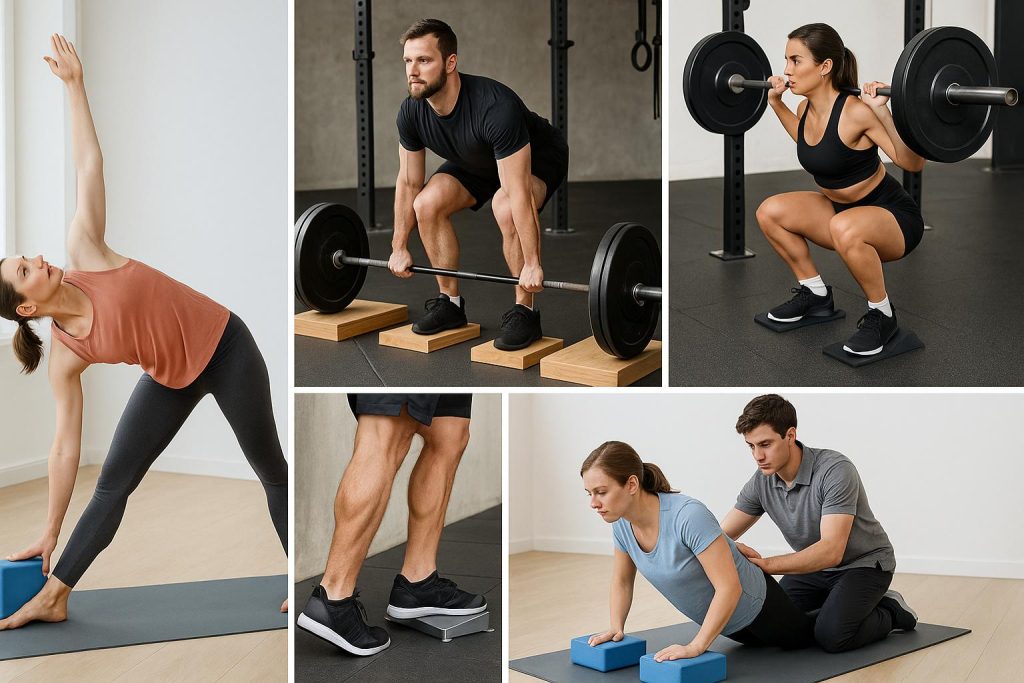Gym blocks are essential fitness tools used to support, stabilize, and enhance a wide range of exercises—improving form, increasing flexibility, and helping athletes at all levels get more from their workouts. Whether in yoga, weightlifting, or physical therapy, gym blocks play a crucial role in maximizing results and minimizing injury risk.
Knowing how gym blocks are used empowers you to work out smarter, not harder. This guide explains their key functions, benefits, types, and practical usage tips—so you can get the most from every training session.

What Are Gym Blocks?
Gym blocks (sometimes called exercise blocks, yoga blocks, lifting blocks, or squat wedges) are rectangular props made from foam, cork, wood, or dense plastic. They serve as sturdy supports in workouts and are commonly found in gyms, yoga studios, and home fitness setups.
You’ll typically see gym blocks used for:
- Improving alignment and posture (especially in yoga)
- Modifying exercises to suit all ability levels
- Increasing the range of motion in strength and flexibility training
- Supporting rehabilitation and injury prevention
- Enhancing balance and stability during challenging moves
Learn more about gym block types and materials (Yoga Outlet)
Key Uses of Gym Blocks
1. Support and Alignment in Yoga
- Main Purpose: Yoga blocks help maintain correct alignment, bring the floor closer, and make challenging poses accessible—especially for beginners or those with limited flexibility.
- Examples:
- Triangle Pose: Place a block under your hand to avoid straining the lower back.
- Seated Forward Fold: Use a block under the forehead or knees for extra support.
- Why It Matters: Using a block ensures better form, reduces risk of overstretching, and helps build confidence in practice.
Yoga Alliance: How to Use Yoga Blocks
2. Technique and Safety in Weightlifting
- Main Purpose: Weightlifting or pulling blocks are sturdy platforms used to elevate the barbell, allowing lifters to practice movements from various heights safely.
- Benefits:
- Isolate and strengthen specific phases of the lift (e.g., mid-shin, below the knee).
- Reduce stress on the lower back and prevent bad form—especially for beginners or during rehab.
- Recent Trend (2025): Many Olympic lifting gyms use blocks for deadlifts, cleans, and snatches to optimize explosive power and reduce injury risk.
Squat University: Using Blocks for Weightlifting
3. Improved Mobility with Squat Wedges and Heel Blocks
- Main Purpose: Squat wedges and heel lift blocks elevate the heels during squats, lunges, or split squats, allowing deeper movement for those with limited ankle mobility.
- Key Benefits:
- Enhance squat depth and quad activation.
- Reduce forward lean and back stress.
- Make squats accessible for beginners and safer for those with tight calves.
- Pro Tip: Physical therapists now widely recommend wedge blocks for clients with ankle mobility issues (updated recommendations in 2024).
Science Behind Squat Wedges (SquatWedgiez.com)
4. Calf Raise Blocks for Muscle Isolation
- Main Purpose: Calf blocks elevate the front of the foot, enabling a full stretch at the bottom and maximum contraction at the top of calf raise exercises.
- Use Cases:
- Standing, seated, or donkey calf raises.
- Rehab for Achilles tendon injuries.
Top Ways to Use a Calf Raise Block (Forte Fitness)
5. General Exercise Modifications & Rehab
- Main Purpose: Gym blocks are used by physical therapists and trainers to modify classic moves (e.g., push-ups, bridges), making them easier or more challenging depending on the user’s needs.
- Who Benefits:
- People recovering from injuries.
- Beginners easing into new routines.
- Advanced athletes seeking deeper range of motion.
Main Types of Gym Blocks
| Block Type | Common Material | Best For |
|---|---|---|
| Yoga Blocks | Foam/Cork/Wood | Flexibility, Balance, Yoga |
| Weightlifting Blocks | Wood/Plastic | Deadlifts, Olympic Lifts |
| Squat Wedges | Rubber/Wood | Squats, Lunges, Mobility |
| Calf Raise Blocks | Metal/Rubber | Calf Raises, Stretching |
Pros and Cons of Using Gym Blocks
- Pros:
- Improve exercise safety and comfort
- Help with proper alignment and injury prevention
- Versatile for all levels and training goals
- Cons:
- Over-reliance can slow progress in flexibility/mobility
- Poor-quality blocks may slip or deform—always choose reputable brands
Latest Policies & Buying Advice
- Prices:
- Foam yoga blocks: $8–$20
- Cork blocks: $15–$30
- Lifting blocks: $80–$250 (per set)
- Squat wedges: $30–$90 (per pair)
- Recent Updates:
- Many leading gyms now provide blocks as standard equipment for all group fitness classes (updated 2024).
- Online retailers increasingly offer eco-friendly, recycled material blocks as sustainability grows in popularity.
ASTM International Fitness Equipment Standards
Frequently Asked Questions
Are gym blocks necessary for beginners?
Yes, especially for yoga, stretching, and those learning proper lifting form. They make exercises safer and more effective.
Can gym blocks help with injury rehab?
Absolutely. Many physical therapists use blocks to modify exercises for injury prevention and post-rehab progressions.
How do I clean and care for gym blocks?
Wipe foam or cork blocks with mild soap and water; avoid harsh chemicals. Let dry fully before use.
Conclusion
Gym blocks are simple yet powerful tools that can transform your workout experience—whether you’re a yoga enthusiast, strength athlete, or beginner. Start using them to support your training, improve your form, and make every rep count.
Ready to level up your fitness? Try adding gym blocks to your next workout and feel the difference!
